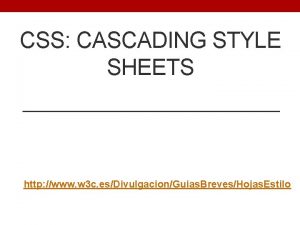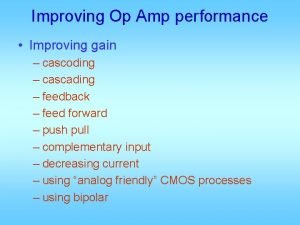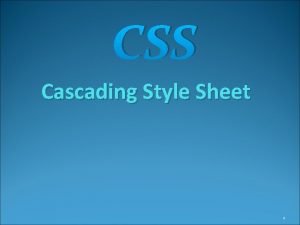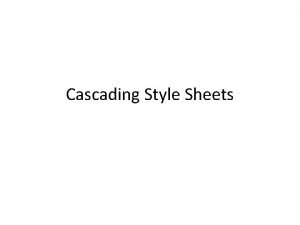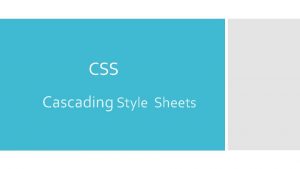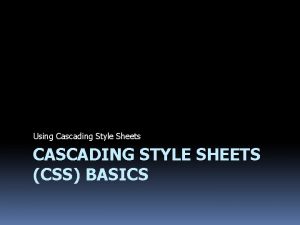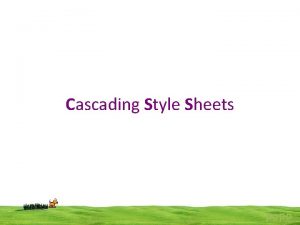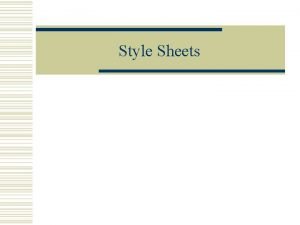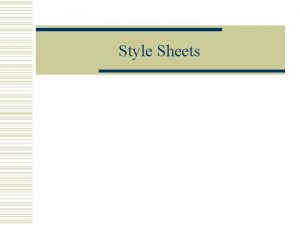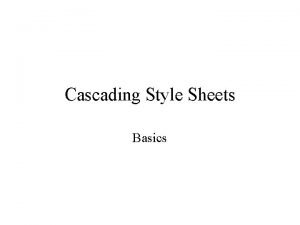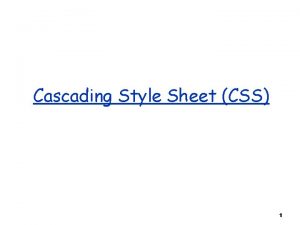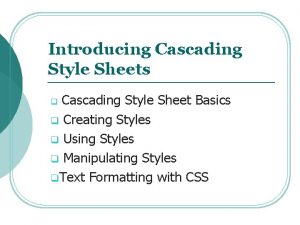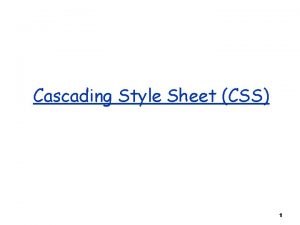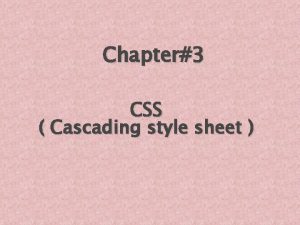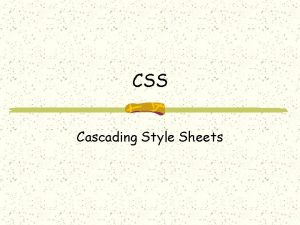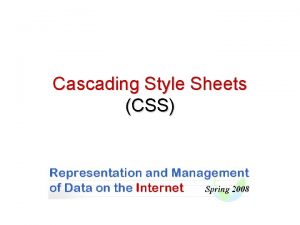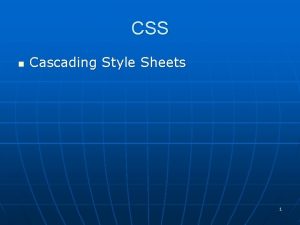Cascading Style Sheets Next Level Cascading Style Sheets




















- Slides: 20

Cascading Style Sheets

Next Level Cascading Style Sheets (CSS) - control the look and feel of your HTML documents in an organized and efficient manner. n With CSS you will be able to: n n Add new looks to your old HTML Completely restyle a web site with only a few changes to your CSS code Use the "style" you create on any webpage you wish!

CSS Selector CSS selectors are the heart and soul of CSS. n They define which HTML elements you are going to be manipulating with CSS code n In a typical CSS statements you have the following: n n n SELECTOR { PROPERTY: VALUE } Where the property is the CSS element you wish to manipulate and "VALUE" represents the value of the specified property.

CSS Selector If you wanted to change the way a paragraph tag behaved the CSS code would look like: n p { PROPERTY: VALUE } n NOTE: The styles must be define in the HEAD of the HTML page NOT in the body page. n

Internal “Local” Styles: ex 6 a. html <html> <head> <style type="text/css"> p {color: white; } body {background-color: black; } </style> </head> <body> <p>White text on a black background!</p> </body> </html>

CSS – General Format "HTML tag" { "CSS Property" : "Value" ; } <p> t We chose the HTML element we wanted to manipulate. - p{ : ; } t Then we chose the CSS attribute color. - p { color: ; } t Next we chose the font color to be white. - p { color: white; } <body> t We choose the HTML element Body - body { : ; } t Then we chose the CSS attribute. - body { background-color: ; } t Next we chose the background color to be black. - body { background- color: black; }

CSS – General Format and example <html> <head> <style type="text/css"> body { background-color: gray; } p { color: maroon; } </style> </head> <body> <h 2>Internal CSS</h 2> <p>This page uses internal CSS. Using the style tag we are able to modify the appearance of HTML elements. </p> </body> </html>

Some pre-defined colors Here are some of the colors and the predefined hexadecimal number Black Gray Silver White Maroon Red Magenta Purple Blue Navy 000000 808080 C 0 C 0 C 0 FFFFFF 800000 FF 00 FF 800080 0000 FF 000080 Cyan Teal Green Olive Lime Yellow 00 FFFF 008080 008000 808000 00 FF 00 FFFF 00

Text-level Styles font-family Named font Use quotations for multiple names: "Courier New" font-size Percent relative to font size of parent element font-style Normal, italic, oblique Bold, bolder, lighter, normal font-weight Named color, #hexcolor background-color Name color, #hexcolor Bolder is equivalent to what <b>. . </b> creates color Makes solid colored block around text.

Generic text-level styles t You can predefine how you want a set of text to be displayed instead of the default given. t Use <span> tag: n Example: <span> text to be different </span> t In the style section, you define what you want for the span tag ie. n span { font-size: 150%; font-family=Verdana; color: maroon; }

Internal CSS Exercise: ex 6 b. html t use internal style definitions, construct the following page at the bottom. t You need to modify or stylize the following: n n <p> - text in maroon <h 2> - text in blue <b> - text in black (hint your default will be maroon based on the “paragraph” setting” <body> - gray

Types of Style - Classes Recall that as styles are defined as t element_name { property 1: value; property 2: value; } example: p {font-size: 150%; color: blue; } t What if you want to have different types of “paragraphs”? t You create “subclasses” and define them as follows: element. classname { property 1: value; property 2: value; } example: p. bigblue {font-size: 150%; color: blue; } p. smallred {font-size; 50%; color: red; } Placed Period here

Types of Style - Classes <style type="text/css"> span {font-weight: normal; font-size: normal; } span. boldred {font-weight: bolder; color: red; } span. italicblue {font-style: italic; color: blue; } b {font-size: normal} b. big {font-size: 150%; } b. small {font-size: 75%} b. bigbolder {font-size: 150%; font-weight: bolder; } </style>

Calling a “class” <style type="text/css"> span {font-weight: normal; fontsize: normal; } span. boldred {font-weight: bolder; color: red; } span. italicblue {font-style: italic; color: blue; } b {font-size: normal} b. big {font-size: 150%; } b. small {font-size: 75%} b. bigbolder {font-size: 150%; fontweight: bolder; } </style> <span> This will be normal </span> <span class="italicblue"> This line will be in italic and blue </span <b>this is normal bold </b> <b class=small>this is smaller bold </b> <b class=bigbolder>this is BIG BOLDER </b>

External Cascading Style Sheet t When creating web pages, it is preferable to keep the style on a t t separate sheet Placing CSS in a separate file allows the web designer to completely differentiate between content(HTML) and design(CSS). It keeps your website design and content separate. It's much easier to reuse your CSS code if you have it in a separate file. Instead of typing the same CSS code on every web page you have, simply have many pages refer to a single CSS file with the "link" tag. You can make drastic changes to your web pages with just a few changes in a single CSS file.

my. Style. css body { background-color: gray; } p{ color: blue; } h 3 { color: red; } ex 6 b. html <html> <head> <link rel="stylesheet“ type="text/css" href= "my. Style. css" /> </head> <body> <h 3> A Red Header </h 3> <p>This paragraph has a blue font. The background color of this page is gray because we changed it with CSS! </p> </body> </html>

Fun and Goodies – Pseudo Classes t Probably the coolest thing about CSS is the ability to t t t add effects to your anchor tags, otherwise known as hyperlinks A link has four different states that it can be in that can be customized. link - this is a link that has not been used, nor is a mouse pointer hovering over it visited - this is a link that has been used before, but has no mouse on it hover - this is a link currently has a mouse pointer hovering over it/on it active - this is a link that is in the process of being clicked

How to define links? a: STATE'S NAME { attribute: value; } Style definition: a: link { color: blue; } a: visited { color: red; } a: hover { color: green; } HTML call: <a href="">This is a special CSS Link</a>

How to remove default underline? a: (STATE'S NAME) { attribute: value; } Style definition: a: link { color: blue; text-decoration: none; a: visited { color: red; text-decoration: } none; } a: hover { color: green; } More fancy a: link { text-decoration: none; color: gray; } a: visited { text-decoration: none; color: gray; } a: hover { text-decoration: none; color: maroon; font-weight: bolder; }

Exercise 7 – Modify exercise 5 t Modify your exercise 5. Copy the whole directory ex 5 to ex 7 directory t Include an external cascading style sheet in both home. html and projects. html t Modify the link so that the links have no underlines and when you “hover” the links, it changes color. See sample code.
 Cascading style sheets outlook
Cascading style sheets outlook Cascading style sheets definition
Cascading style sheets definition X.next = x.next.next
X.next = x.next.next Syntactically awesome stylesheets
Syntactically awesome stylesheets Next level innovations
Next level innovations Event
Event Next level building
Next level building Contoh logic model
Contoh logic model Fractional cascading
Fractional cascading Cascading dynamic gates
Cascading dynamic gates Pneumatic drawing
Pneumatic drawing Sample strategy map
Sample strategy map Cascading consequences
Cascading consequences Cascading behavior in networks
Cascading behavior in networks Cmfb
Cmfb Mnemonic code
Mnemonic code Cascode amplifier dc analysis
Cascode amplifier dc analysis Ons instruction
Ons instruction Beda pohon kinerja dan cascading
Beda pohon kinerja dan cascading Cascading order
Cascading order What is cascading effect?
What is cascading effect?

